Key takeaways:
- Walkable neighborhoods prioritize pedestrians, allowing easy access to essential services and fostering social connections.
- They promote healthier lifestyles through increased physical activity and social interactions, benefiting both personal well-being and local economies.
- Key design elements include mixed-use developments, pedestrian-friendly layouts, and effective lighting, which enhance community engagement and enjoyment.
- The future of walkable neighborhoods focuses on sustainability, technology integration, and community involvement, ensuring spaces meet residents’ needs and preferences.
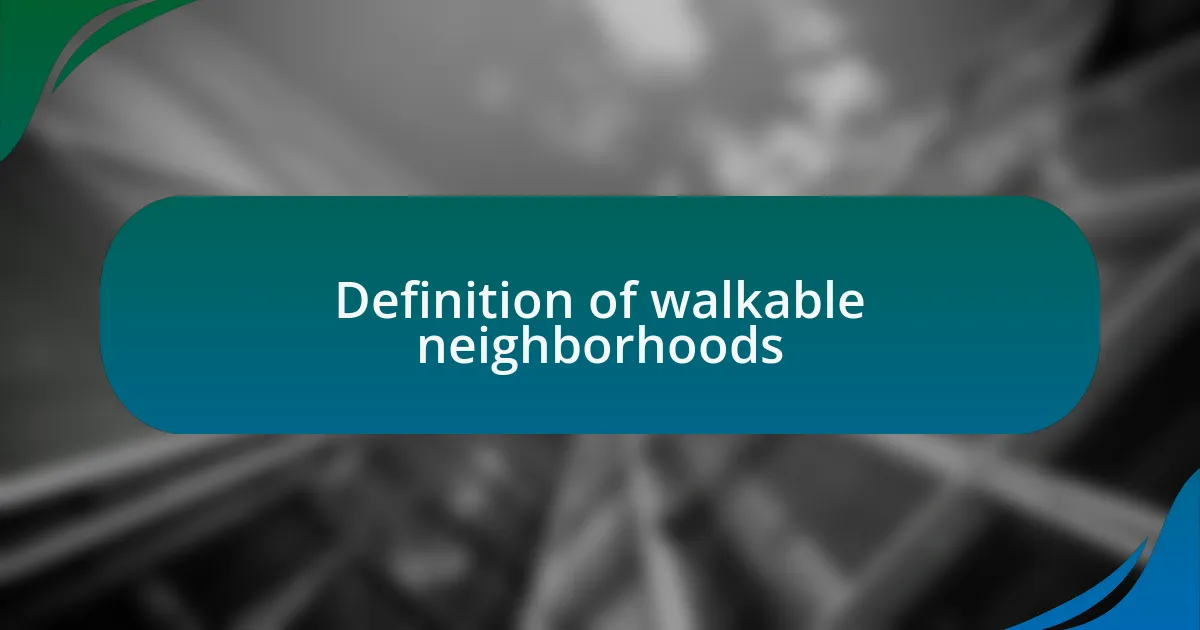
Definition of walkable neighborhoods
Walkable neighborhoods are areas designed to prioritize pedestrians over vehicles, enabling residents to access essential services like shops, schools, and parks within a comfortable walking distance. I remember living in a community where I could stroll to the local bakery every Saturday morning, enjoying the sights and sounds of my neighborhood. It made me ponder: how much richer would our lives be if more places were this accessible?
These neighborhoods typically feature sidewalks, pedestrian-friendly street designs, and a mix of residential and commercial spaces, fostering a sense of community. When I think about the vibrant interactions I witnessed in such areas—a child learning to ride a bike, neighbors chatting on their front porches—it becomes evident that these spaces are not just about convenience; they enhance social connections.
Ultimately, a walkable neighborhood is a place where the environment encourages movement and interaction among its residents. Have you ever felt the joy of bumping into a friend while out for a walk? It’s these spontaneous moments that highlight the value of designing spaces that invite people out of their cars and into the heart of their community.
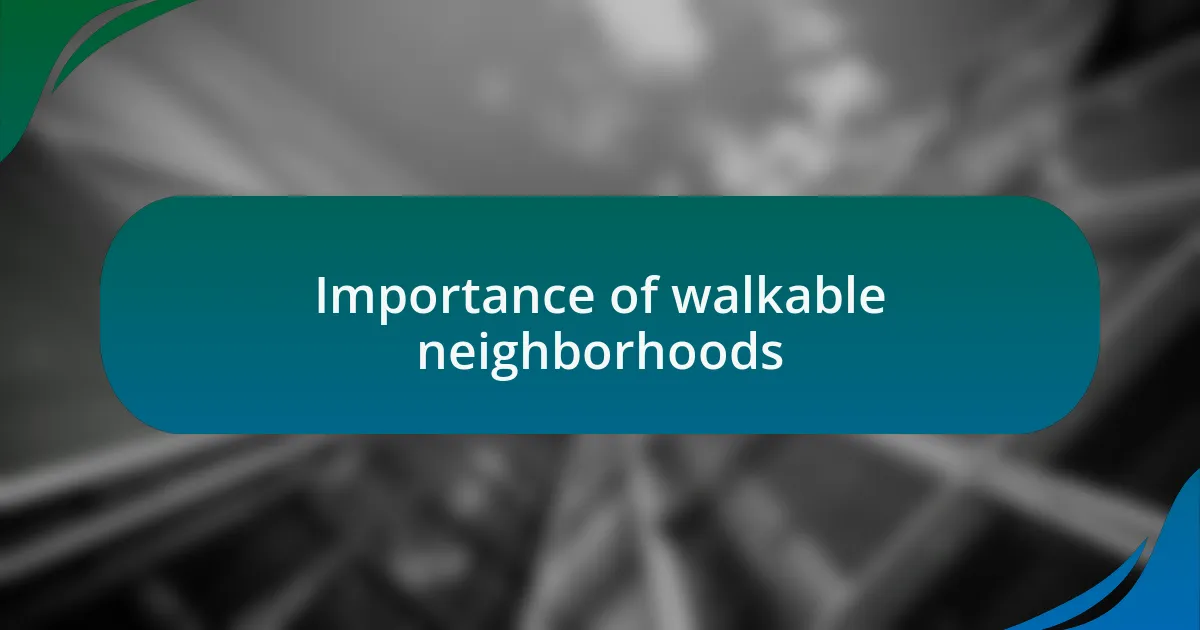
Importance of walkable neighborhoods
The significance of walkable neighborhoods cannot be overstated. From my own experience, living in such an area has profoundly affected my daily routine, encouraging me to leave my car behind and embrace walking. I recall the invigorating feeling of taking a leisurely stroll to the local coffee shop, where I would often run into friends and neighbors, each encounter adding a little warmth to my day.
Another crucial aspect is the health benefits that come from walkable neighborhoods. I can’t help but reflect on how convenient access to parks and recreational spaces has fostered a more active lifestyle for me. When I see families playing outside or joggers enjoying the landscape, it’s clear that these environments promote physical health and well-being—an invaluable contribution to our quality of life.
Beyond personal enjoyment and physical health, walkable neighborhoods encourage economic vitality. I’ve noticed how local businesses thrive in areas where foot traffic is high, creating a vibrant marketplace full of unique shops and eateries. Isn’t it fascinating how a simple walk can lead to a local discovery, enhancing both the community and the economy simultaneously?

Key features of walkable neighborhoods
When I think about walkable neighborhoods, one standout feature is their design, which often includes narrow streets, well-placed sidewalks, and easily accessible public transportation. On my walks, I’ve appreciated how the layout encourages exploration, making each turn an invitation to discover something new—be it a quirky bookstore or a cozy café. Doesn’t it feel rewarding to stumble upon hidden gems right in your own community?
Another key aspect is the presence of mixed-use buildings that combine residential, commercial, and recreational spaces. I’ve found myself in neighborhoods where I can grab groceries, visit a library, and then enjoy dinner—all within a few blocks. This blend not only fosters a sense of community but also reduces reliance on cars, making errands feel more like an enjoyable adventure rather than a chore.
Community engagement is another hallmark of walkable neighborhoods. I remember joining a local block party where neighbors came together to share food, music, and laughter. Such gatherings strengthen bonds and create a shared identity, transforming mere streets into vibrant hubs of interaction. Have you ever participated in something like this? It’s those moments that remind me how a simple walk can lead not just to better health, but to a deeper connection with those around us.

Benefits of walkable neighborhoods
When considering the benefits of walkable neighborhoods, I can’t help but reflect on how they promote a healthier lifestyle. On my daily walks, I often notice more people jogging, strolling, or biking, which creates a lively atmosphere. Isn’t it incredible how simply making the choice to walk instead of drive can lead to better physical and mental well-being?
Social interaction flourishes in these environments as well. I remember one sunny afternoon when I unexpectedly ran into a friend while walking to a nearby park. That chance meeting sparked a spontaneous picnic, reminding me how walkable neighborhoods can transform isolated moments into shared experiences. Have you ever realized that a simple trip can morph into meaningful connections with others?
Moreover, these neighborhoods tend to enhance local economies. When I shop at local stores rather than driving to a big-box retailer, I feel a sense of contribution to my community. It’s satisfying to know that my spending is supporting my neighbors and fostering small businesses. Do you also find joy in knowing your everyday choices can create a ripple effect in your community?
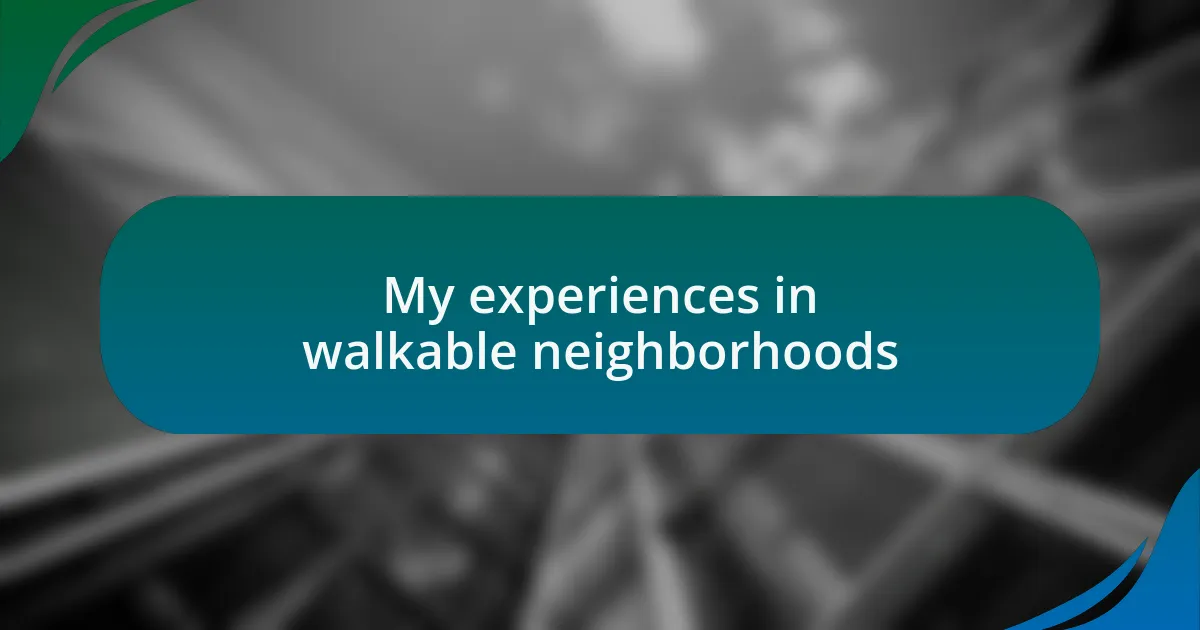
My experiences in walkable neighborhoods
Walking through a neighborhood where everything is within reach has deeply influenced my daily routine. I think back to my last visit to a friend’s walkable area, where I could grab a coffee from a local café and enjoy it in the nearby park. That simple pleasure – sipping a warm drink while surrounded by nature – made me realize how much more connected I feel to my environment when I’m on foot.
One evening, I decided to take a longer route home and stumbled upon a street fair that I would have easily missed if I had been driving. The smell of food, the sounds of laughter, and the vibrant displays caught my eye, pulling me in. Isn’t it fascinating how unplanned experiences often lead to the most memorable moments? Moments like these remind me that the joy of discovery is often hidden just around the corner in a walkable neighborhood.
I’ve also come to appreciate how these spaces foster community events. A few months ago, I attended a farmers’ market just a few blocks away from my home. The sense of camaraderie among vendors and residents created a welcoming vibe that’s hard to replicate in less accessible areas. I often wonder if others feel this same sense of belonging when they engage with their neighborhood on foot, as it can truly enrich our lives and enhance our sense of place.
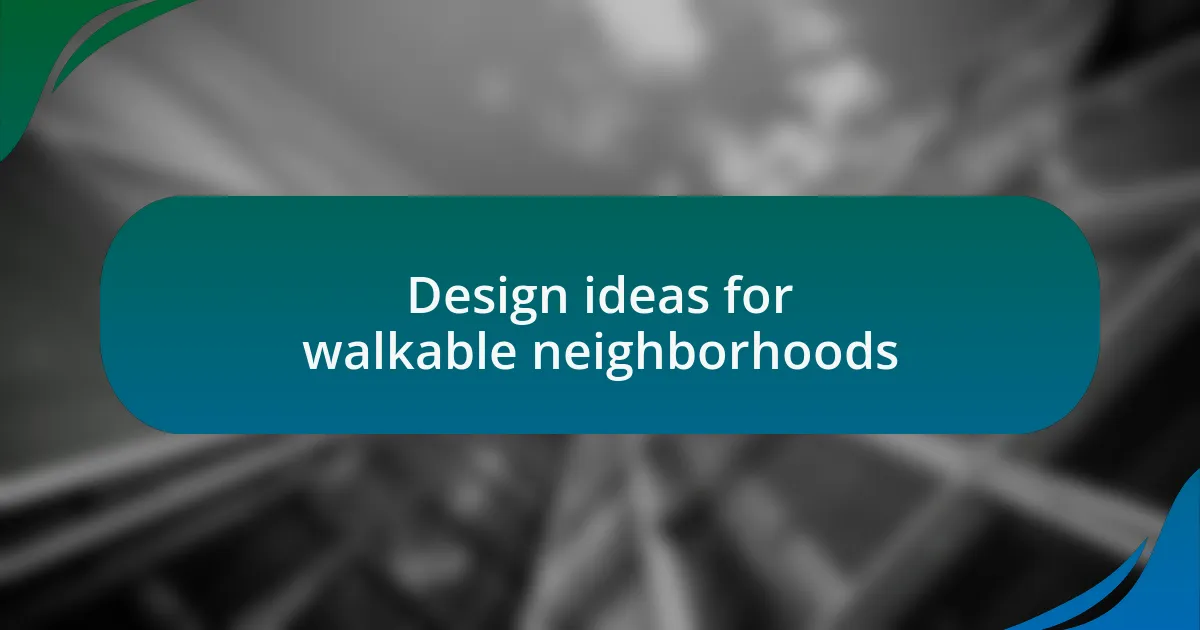
Design ideas for walkable neighborhoods
When thinking about design ideas for walkable neighborhoods, I often envision inviting street layouts that prioritize pedestrians. Imagine wide sidewalks adorned with benches, trees, and flowering plants, making each stroll delightful. When I walk in areas that feel welcoming and vibrant, I sometimes think about how these thoughtful details create natural gathering spots for neighbors and visitors alike.
One concept I find particularly compelling is the integration of mixed-use developments. These spaces blend residential, commercial, and recreational facilities, allowing for a lively atmosphere that encourages foot traffic. I recall a neighborhood where I could easily access my favorite bakery, gym, and bookstore all within a few blocks. Doesn’t it make you feel empowered to have everything you need close by? This kind of design not only promotes walking but also fosters a sense of community.
I’ve also seen how effective lighting can dramatically impact walkability. In a well-lit street adorned with artistic fixtures, I often feel more secure and inclined to explore after sunset. There was a time I took an evening stroll through a beautifully illuminated plaza, and I couldn’t help but feel a sense of wonder as I watched families and friends congregate. Isn’t it interesting how the right ambiance can change our relationship with a space? This highlights that well-considered design, including adequate lighting, can transform ordinary streets into inviting experiences that draw people out into their neighborhoods.
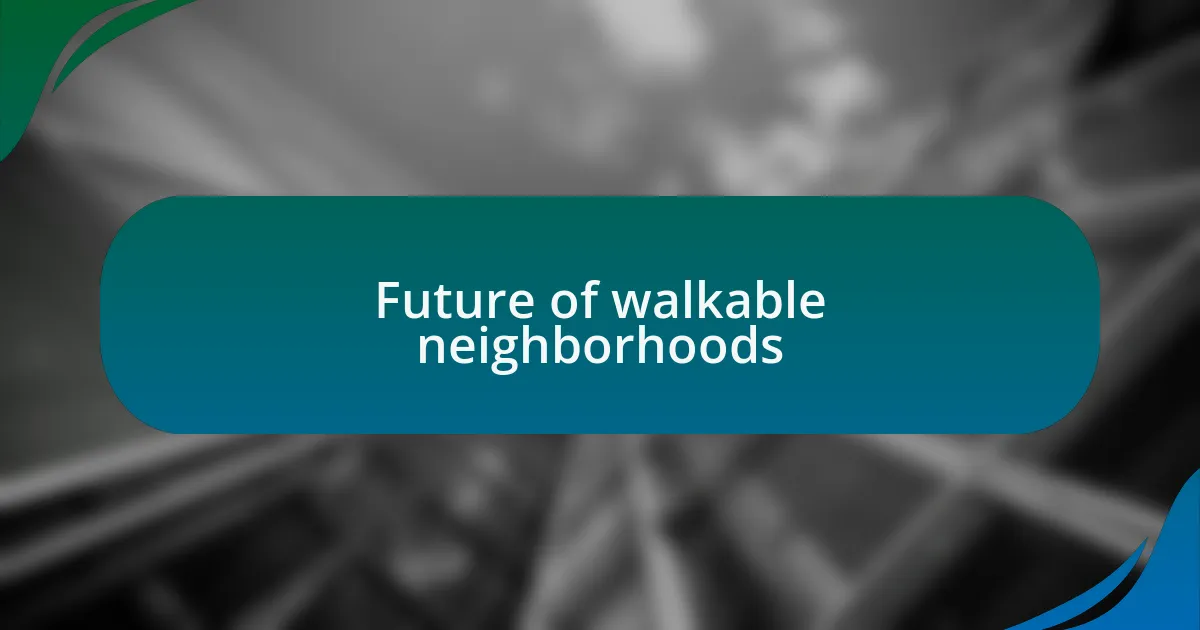
Future of walkable neighborhoods
The future of walkable neighborhoods excites me as urban planners increasingly prioritize sustainability and livability. I recently read about a city that transformed its urban layout by introducing car-free zones, allowing pedestrians to reclaim streets that once felt dominated by traffic. Isn’t it fascinating to think about how these changes not only create safer spaces but also promote healthier lifestyles by encouraging walking and cycling?
In many cities, the integration of smart technology is reshaping how we interact with our neighborhoods. I remember visiting a place where digital wayfinding signs guided me to nearby parks and local shops, enhancing my exploration experience. It sparks the question: how can we leverage technology further to make our neighborhoods more engaging and user-friendly?
Looking ahead, I’m convinced that community involvement will be key. Engaging residents in the design process creates a sense of ownership and belonging. I participated in a local workshop where neighbors discussed ideas for improving public spaces, and it was uplifting to see so many voices coming together. Doesn’t that highlight the power of collaboration in creating neighborhoods that truly reflect the needs and desires of their inhabitants? It seems clear that the future of walkable neighborhoods is not just about infrastructure; it’s about building vibrant communities rooted in connection and participation.